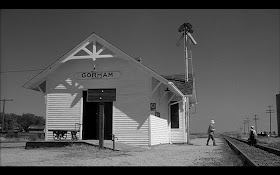Here are three of my favorite poems, all on a single theme, by Mark Strand [1934- ], Daniel Halpern [1945- ] and Donald Justice [1925-2004]. Each speaks, in its way, of presence and absence, in each instance the speaker's (or poet's) presence against the emptiness of an implied, or an addressed, sense of absence. Nothingness, as a quality one might go about describing, is a riddle--an imagined space within which presence might exist, or the lack of an agency outside one's sense of consciousness (of being itself), or as an audience of none, a projection into a void from which nothing returns.
Keeping Things Whole
In a field
I am the absence
of field.
This is
always the case.
Wherever I am
I am what is missing.
When I walk
I part the air
and always
the air moves in
to fill the spaces
where my body's been.
We all have reasons
for moving.
I move
to keep things whole.
--Mark Strand
Strand's poem proposes an abstract "field"--the field of the poem, a literal field of grey grass perhaps, or an energy field. The self is both the literal body (and consciousness) of a single human being, moving across, or through, this field, a fluidity of air which surrounds it, and which closes in behind as he passes. The "wholeness" of the universe is a conception, a mental impression only made possible by a conscious observer, therefore wholeness can only be achieved through the literal vitality of a self-consciously moving being. But self-consciousness is a kind of absence, too: Non-being can only be imagined by a being with consciousness. The self's separateness--its "absence" within the greater field of the universe--conjugates its own mortality, its eventual effacement, "missing" forever after death.
White Field
It is like standing beyond
a snowfield with a single
set of footprints across it
and you say, Those prints are mine
because no one else has ever been here.
All day the snow comes down,
all day you tell yourself what you feel,
but you remain in that place
beyond the snowfield.
Is there better proof
of your presence than
this open field, where you stand
now looking back across the white
expanse that is once more new to you?
As snow fills the places
where you must have walked,
you start back to where you began,
that place you again prepare to leave,
alone and warm, again intact, starting out.
--Daniel Halpern
Aside from a couple of quibbles--I see no reason for such "filler" lines as "and you say" or "all day you tell yourself what you feel" and I would put the lines "where you stand/now looking back across the white/expanse that is once more new to you" after "As snow fills the places/where you must have walked" closing up the space so that "This open field" [full-stop] leads directly into "As snow fills...."--this poem's a brilliant description of a common feeling or sensation many people have had.
As in Strand's poem, this one addresses a "field"--a field of snow, which is continuously being replenished, or re-covered, by more falling snow--the sense of the passage of a mortal consciousness through the universal force field of matter, time, leaving a temporary trace, which is effaced gradually by the filling in of one's footsteps or passage, through the field, of an erosion or covering over, in the material flux. The brief evidence of having even existed at all, its fragility and temporariness, is vividly evoked. The sense of a cyclical rehearsal of the movement through time (and space)--"you start back to where you began"--rather like Eliot's circular reincarnation trope in Four Quartets--and the sense of an individual identity ("Those prints are mine/because no one else has ever been here") vouchsafed from eternity, but whose presence will eventually become an absence.
Fragment: To a Mirror
Behind that bland facade of yours,
What drafts are moving down that intricate maze
Of halls? What solitude of attics waits,
Bleak, at the top of the still hidden stair?
And are those windows yours that open out
On such spectacular views?
Those still bays yours, where small boats lie
At anchor, abandoned by their crews?
The parks nearby,
Whose statues doze forever in the sun?
The stricken avenues,
Along which great palms wither and droop down
Their royal fronds,
And the parade is drummed
To a sudden inexplicable halt?
Tell me,
Is this the promised absence I foresee
In you, when no breath any more shall stir
The milky surface of this sleeping pond,
And you shall have back your rest at last,
Your half of nothingness?
--Donald Justice
Justice's poem is a much more complex effort, addressed "to a mirror" rather than to an imagined audience of reader(s). The mirror is almost a character, in the sense of an imagined consciousness of an other, in a blank dialectic of a single voice reflected off itself. The metaphors--the maze of halls, the attic, the bay views, the boats, statues and great palms in the parks and "stricken" avenues, the halted parade--all summoned to evoke a premonitory absence (of the poet), enumerate details which will continue to exist long after the conscious perceiver is departed. The other "half" of loneliness is the poet's own ephemeral reflection, the mirror's passive replication of his physical presence, his performance of memories of events and objects beyond (his) time, echoing in ever-multiplying symmetry, forever.

















